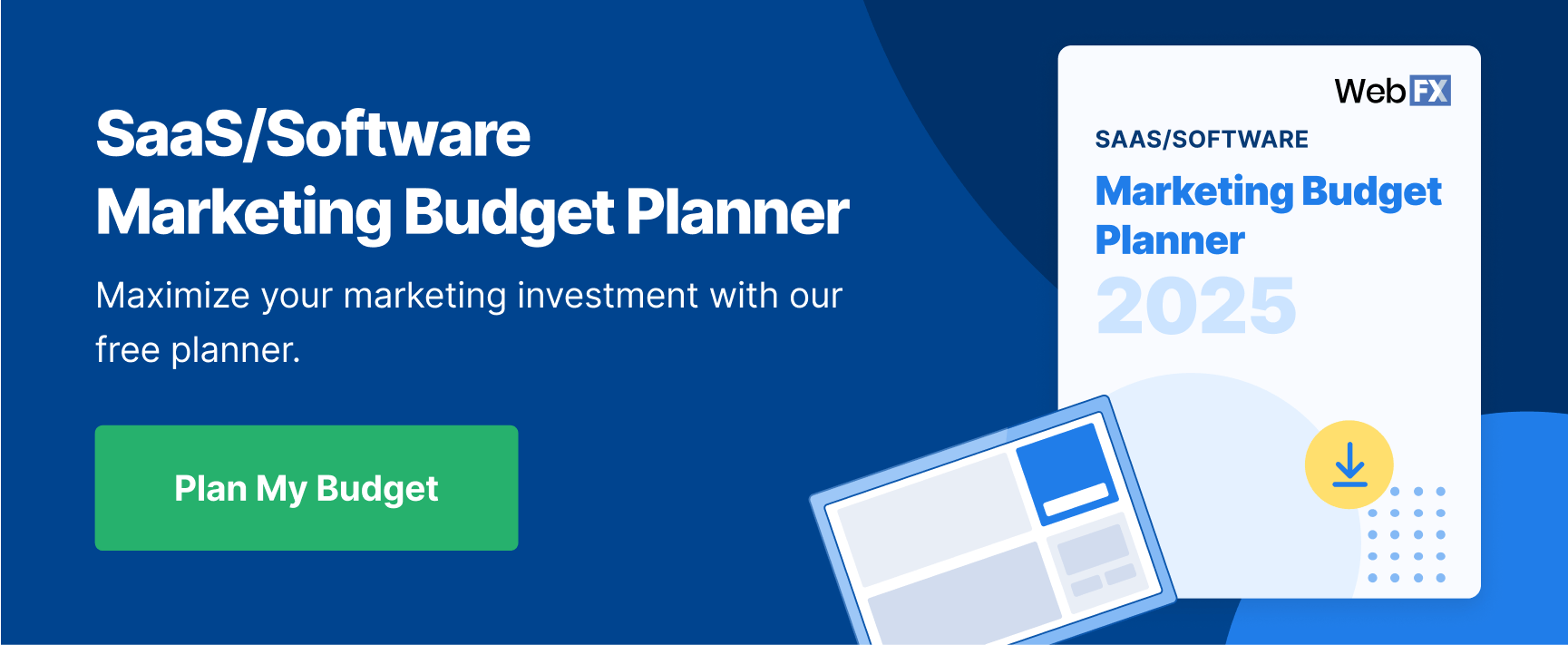- Home
- Industries
- Tech
- Software
- saas marketing budget
How To Optimize Your 2025 SaaS Marketing Budget
Software as a service (SaaS) companies face a competitive, ever-growing industry. Your marketing plan is just as important as your product at this point — it’s what differentiates your business from the others in your market. To excel beyond your competitors, you need a solid SaaS marketing budget.
-
insights from 85,500+ hours of technology marketing experience
How much do SaaS companies spend on marketing?
SaaS companies spend between 7% and 15% of their annual revenue on marketing, on average.
Below, we will cover everything you need to create yours, along with some industry budget data:
- How much do SaaS companies spend on marketing?
- SaaS marketing budget breakdown
- Factors that impact SaaS marketing budgets
- How to create a SaaS marketing budget
- FAQs on SaaS marketing budgets
 Download: Free SaaS Marketing Budget Planner
Download: Free SaaS Marketing Budget Planner
How much do SaaS companies spend on marketing?
SaaS companies spend between 7% and 15% of their annual revenue on marketing, on average.
SaaS marketing budget breakdown
Planning a SaaS marketing budget means knowing not only what you’re spending, but also how you’re spending your funds. Understanding the costs of digital marketing strategies is a great place to start.
You can get an idea of how much to pay by looking at the average cost of digital marketing by service:
|
2025 SaaS Marketing Spend |
|
| Channel | Monthly Spend |
| Paid Advertising *Including Google Ads, LinkedIn ads, retargeting ads, etc. |
$100-$10,000 |
| Search Engine Optimization (SEO) | $2,500-$7,500 |
| Social Media *Includes webinars, live demos, etc. |
$100-$5,000 |
| Email Marketing & SMS | $50-$100 |
| Web Design | $501-$5000 per year |
Factors that impact SaaS marketing budgets
You should also consider industry-specific factors that affect your marketing budget. Here are the top factors to note:
- High competition: The SaaS is notoriously competitive, which means your marketing is key to helping you stand out (and make sales). Investing more in marketing, or investing wisely, will help you overcome the competition.
- High customer acquisition costs (CAC): It costs more to get people on board with your business, which means your budget should account for a high CAC. You should monitor your strategies’ effectiveness to make sure you’re offsetting those costs.
- Difficulty with retention: Once you get people on board with your services, you want to make sure they stay a customer. You can dedicate part of your budget to maintaining client satisfaction.
- Fast-paced technology changes: Technology changes so quickly, making it difficult to keep up consistently. Your marketing budget should help fuel your research and understanding of technology trends and updates.
How to create a SaaS marketing budget
How To Create Your 2025 SaaS Marketing Budget
- Allocate around 7-15% of your total revenue for marketing
- Reserve between 5-10% of your marketing budget to invest in new marketing strategies
So, how do you actually create a software company marketing budget? Here are four steps you can follow to get started:
- Define your SaaS budget categories
- Outline specific growth goals
- Factor in tech market conditions and competition
- Set a realistic budget aligned with your SaaS growth stage
Learn more below!
1. Define your SaaS budget categories
The first step to creating a software company budget is understanding your needs.
The standard is to allocate 7-15% of your revenue for marketing. You might invest more if you have the available revenue and want to see faster growth, however, or less if you are dealing with higher costs elsewhere.
During this step, you should:
- Review past budgets and expenses to see where your marketing spend went
- Evaluate the effectiveness of past campaigns to know which drove revenue
- Consider what channels you want to use for the coming year
2. Outline specific growth goals
Once you determine what strategies to invest in, you can set goals for 2025. Creating SMART goals — those that are Specific, Measurable, Attainable, Relevant, and Timely — will help you set realistic checkpoints for your budget.
An example of a SMART goal for software companies could be “We want to increase sales by X percent in the next 12 months.”
Having these goals in mind will help you evaluate your budget moving forward.
3. Factor in tech market conditions and competition
After setting goals and identifying your top-performing channels, you must determine the marketing initiatives needed to achieve your goals.
One place to start is with your competition. Evaluate your competitors’ spending habits, preferred channels, and successes to see where you should be allocating your budget. If they are ranking in the search results, you should be right up there with them.
You should also be paying attention to SaaS industry trends to see what marketing tactics are current in your market.
4. Set a realistic budget aligned with your SaaS growth stage
Finally, now that we’ve established your costs and revenue, you can set your budget.
Remember that your budget may fluctuate throughout the year. To make sure you stay on track, take time each quarter or year to evaluate your costs and revenue and make sure the channels you selected are performing will.
FAQs on SaaS marketing budgets
Want to learn even more about SaaS marketing budgets? Check out our FAQ below!
How much should SaaS companies spend on marketing?
SaaS and computer software companies spend 7-15% of their revenue on marketing, on average.
What is the marketing-to-sales ratio for SaaS?
SaaS companies typically spend around 7-15% of their revenue on marketing, and 30-50% of their annual revenue on sales and marketing combined. Where you fall in that range will depend on:
- Your resources
- Your company’s age
- How established you are
- Your CAC and customer lifetime value (CLV)
How to calculate SaaS marketing budget?
To calculate your SaaS marketing budget, you can use a ratio of your CLV to your CAC to determine how much you can spend on marketing. Ideally, your LTV to CAC ratio should be 3:1, meaning you earn three times the amount that you spend to close a deal with a customer.
If your ratio is higher, like 4:1, for example, you can invest more in your marketing to see higher growth. If your ratio is lower, you should look for ways to increase your LTV or lower your CAC.
Create a revenue-driving SaaS marketing budget with WebFX
WebFX understands the challenges that come with marketing a tech company. Our agency has 85,500+ hours of experience in the tech industry. That experience gives you access to problem-solving marketing experts that know how to handle your company’s unique problems.
Our digital marketing services will help you get the most out of every dollar you invest in marketing your company. Contact us today to see how you can boost your ROI and grow your budget YoY!
We Drive Results for Software Companies
- 360+ tech industry experts
- 24 million leads generated for clients



We Drive Results for Software Companies
- 360+ tech industry experts
- 24 million leads generated for clients



Explore our technology case studies
Read our case studies for a more in-depth look at our results.
Solving key challenges for software
Our website isn’t driving enough traffic
Struggling to bring prospective clients to your website? Our team can help you increase your rankings in search results, meeting your audience when they’re looking for your solutions, so you drive more web traffic, leads, and revenue.

We’re not selling our software or services
Launch data-driven marketing and advertising campaigns with your dedicated WebFX team that reach the people most likely to invest in your solutions. The result? You drive more revenue and help achieve your business’s biggest objectives.

We’re struggling to attract new clients
Are you struggling to build your brand awareness and online visibility so more potential clients find you online? With our suite of digital marketing services, you’ll expand your reach and promote your solutions where your audience spends their time online.

We’re not retaining our clients
At WebFX, our marketing experts help you implement effective strategies and processes that help you deliver an amazing customer experience that builds brand loyalty and keeps your company at the forefront of clients’ minds instead of competitors.


